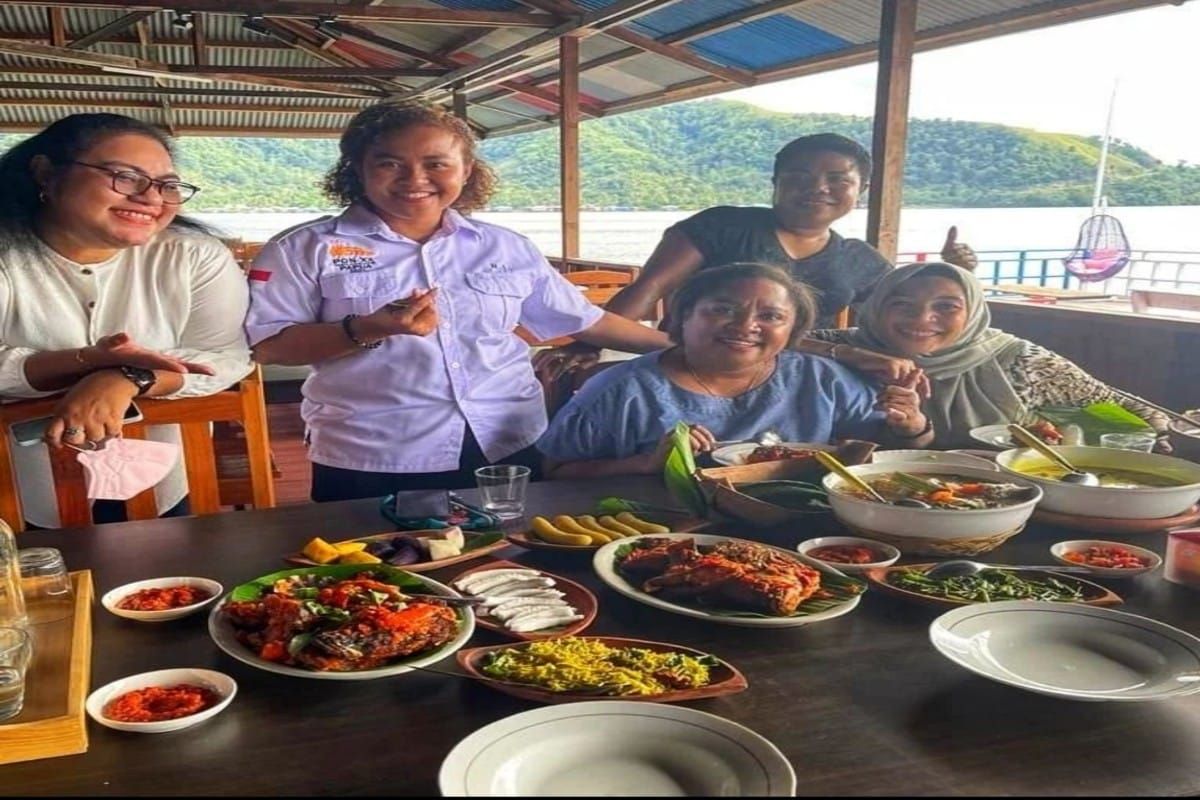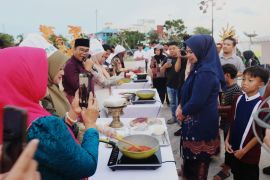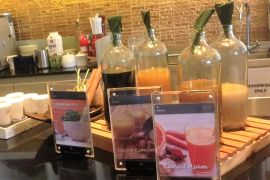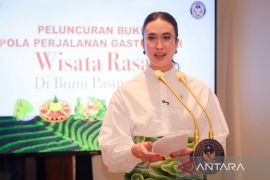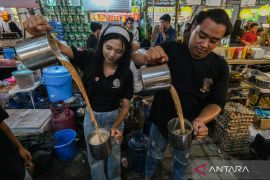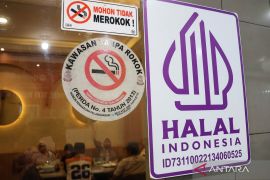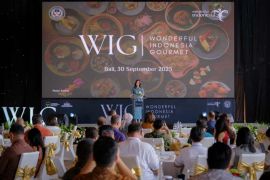Indonesia's region of Papua offers an extensive array of delicacies, some of which are made from exotic ingredients found in the country's eastern regions, such as sago and sayur lilin (saccharum edule).
Papuan people are known for their skills in processing sago into various types of food, including papeda -- sago porridge usually served with fish and yellow broth -- and sinole, which is a sweet snack made from dried sago.
Meanwhile, sayur lilin is a type of sugarcane that can be eaten raw. It takes a form similar to that of lemongrass though larger in size. The people of Papua usually make use of the candle-like inner part of the crop. In Indonesian language, sayur lilin literally means candle vegetable.
In addition, Papua offers snakehead fish in black broth, pounded taro, and smoked fish.
However, those dishes are becoming increasingly rare due to a decline in the supply of their raw materials in nature.
It was the determination to preserve Papuan cuisine that moved Usilina Epa, a Papuan woman, to develop culinary businesses that highlight the region's local dishes.
In 2015, Epa founded her first culinary establishment "Dapur Mama" in Waena Village, Heram District, Jayapura City, Papua Province. However, the restaurant was out of business one month after its opening.
Two years later, Epa once again tried her luck by launching a cafe she named "Sunshine Cafe and Library" with the similar goal of promoting local foods, such as sinole.
As the cafe turned five, Epa opened another establishment called "Isasai Restaurant", focusing on promoting endangered typical foods from the sub-district of Sentani of Jayapura District.
"Back then, Sentani market merchants were selling ready-to-cook smoked snakehead fish. However, the number of such merchants has been declining," the Sentani woman remarked.
Related news: Preserving the sustainability of Papuan staple sago
Since the concept applied in the restaurant is not popular among Papuans, she admitted to having doubts about how the people would respond to the business.
Over time, the restaurant turned out to be successful in attracting customers from Jayapura and beyond. She said the customers were delighted to be able to taste Papuan typical dishes more easily.
According to Epa, the restaurant is still facing raw material shortage as its major stumbling block. She noted that Papuan typical dishes do not require a complex cooking process, but some of them need raw materials whose production rate has been on a decline, resulting in soaring prices.
She said all stakeholders at the national, provincial, and local levels need to work hand in hand to sustain the existence of Papuan cuisine.
"Raw materials are getting more difficult to obtain. Even if the stocks are available, we will need to procure them from other regions at higher prices. It is our shared responsibility to encourage continued planting of local crops in order to tame the prices," she pointed out.
For instance, she remarked that sayur lilin is offered at Sentani Market for Rp70 thousand-100 thousand (US$4.46-6.35), which are relatively unfavorable prices in the eyes of local culinary business actors.
Nevertheless, Epa seems to be unfazed by the shortage. She continues to promote local foods in a contemporary fashion in a bid to draw more young consumers, considering that the elderly constitute a majority of the restaurant's customer base.
Epa expressed hope that by promoting Papuan traditional dishes, she would be able to encourage farmers to plant the associated raw materials on their lands. She believes that in this way, more Papuan women will sell local food ingredients in markets.
She also expected young native Papuans to open similar establishments to partake in preserving the varied Papuan delicacies.
Papuan food heroines
The Agriculture and Horticulture Office of Papua Province has taken measures to revitalize and revive the glory of Papuan local foods, including by promoting local staple food commodities as an alternative to rice to meet the people's calorific requirements.
Moreover, the provincial government has been encouraging residents to capitalize on their lands by planting Papua typical crops in the hopes of solidifying the food resilience of local residents and boosting their economic capacity.
Charles Toto, a native Papuan chef known for promoting local foods by holding culinary events in the middle of the jungle, emphasized that Papua needs more women who hold genuine care for the preservation of the region's authentic dishes. In his view, a plethora of dishes of Papua are still relatively unknown to the broader population of Indonesia.
"Papua, especially its mountainous areas, is still lacking women who are willing to preserve its cuisine," he pointed out.
Bearing that in mind, Toto invited youngsters to enthusiastically learn how to cook Papuan traditional foods to echo stories about Papuan cuisine.
However, he said that Papuan local delights, such as sinole and papeda, had started gaining greater popularity owing to the promotional content circulating on social media platforms.
The high level of nutritional content offered by the raw materials used for making Papuan foods also plays a part in the increasing popularity of Papuan cuisine, he added.
He further drew attention to an increase in the number of events that proffer its traditional delights. Moreover, some hotels have started to include traditional foods in their menus despite being limited to dishes made from easy-to-get raw materials.
"I hope that young people in Papua will pay more attention to local foods, as part of the Papuan identity that needs to be preserved," he concluded.
Related news: From darkness to dishes: How electricity revives Papuan cuisine
Papuan people are known for their skills in processing sago into various types of food, including papeda -- sago porridge usually served with fish and yellow broth -- and sinole, which is a sweet snack made from dried sago.
Meanwhile, sayur lilin is a type of sugarcane that can be eaten raw. It takes a form similar to that of lemongrass though larger in size. The people of Papua usually make use of the candle-like inner part of the crop. In Indonesian language, sayur lilin literally means candle vegetable.
In addition, Papua offers snakehead fish in black broth, pounded taro, and smoked fish.
However, those dishes are becoming increasingly rare due to a decline in the supply of their raw materials in nature.
It was the determination to preserve Papuan cuisine that moved Usilina Epa, a Papuan woman, to develop culinary businesses that highlight the region's local dishes.
In 2015, Epa founded her first culinary establishment "Dapur Mama" in Waena Village, Heram District, Jayapura City, Papua Province. However, the restaurant was out of business one month after its opening.
Two years later, Epa once again tried her luck by launching a cafe she named "Sunshine Cafe and Library" with the similar goal of promoting local foods, such as sinole.
As the cafe turned five, Epa opened another establishment called "Isasai Restaurant", focusing on promoting endangered typical foods from the sub-district of Sentani of Jayapura District.
"Back then, Sentani market merchants were selling ready-to-cook smoked snakehead fish. However, the number of such merchants has been declining," the Sentani woman remarked.
Related news: Preserving the sustainability of Papuan staple sago
Since the concept applied in the restaurant is not popular among Papuans, she admitted to having doubts about how the people would respond to the business.
Over time, the restaurant turned out to be successful in attracting customers from Jayapura and beyond. She said the customers were delighted to be able to taste Papuan typical dishes more easily.
According to Epa, the restaurant is still facing raw material shortage as its major stumbling block. She noted that Papuan typical dishes do not require a complex cooking process, but some of them need raw materials whose production rate has been on a decline, resulting in soaring prices.
She said all stakeholders at the national, provincial, and local levels need to work hand in hand to sustain the existence of Papuan cuisine.
"Raw materials are getting more difficult to obtain. Even if the stocks are available, we will need to procure them from other regions at higher prices. It is our shared responsibility to encourage continued planting of local crops in order to tame the prices," she pointed out.
For instance, she remarked that sayur lilin is offered at Sentani Market for Rp70 thousand-100 thousand (US$4.46-6.35), which are relatively unfavorable prices in the eyes of local culinary business actors.
Nevertheless, Epa seems to be unfazed by the shortage. She continues to promote local foods in a contemporary fashion in a bid to draw more young consumers, considering that the elderly constitute a majority of the restaurant's customer base.
Epa expressed hope that by promoting Papuan traditional dishes, she would be able to encourage farmers to plant the associated raw materials on their lands. She believes that in this way, more Papuan women will sell local food ingredients in markets.
She also expected young native Papuans to open similar establishments to partake in preserving the varied Papuan delicacies.
Papuan food heroines
The Agriculture and Horticulture Office of Papua Province has taken measures to revitalize and revive the glory of Papuan local foods, including by promoting local staple food commodities as an alternative to rice to meet the people's calorific requirements.
Moreover, the provincial government has been encouraging residents to capitalize on their lands by planting Papua typical crops in the hopes of solidifying the food resilience of local residents and boosting their economic capacity.
Charles Toto, a native Papuan chef known for promoting local foods by holding culinary events in the middle of the jungle, emphasized that Papua needs more women who hold genuine care for the preservation of the region's authentic dishes. In his view, a plethora of dishes of Papua are still relatively unknown to the broader population of Indonesia.
"Papua, especially its mountainous areas, is still lacking women who are willing to preserve its cuisine," he pointed out.
Bearing that in mind, Toto invited youngsters to enthusiastically learn how to cook Papuan traditional foods to echo stories about Papuan cuisine.
However, he said that Papuan local delights, such as sinole and papeda, had started gaining greater popularity owing to the promotional content circulating on social media platforms.
The high level of nutritional content offered by the raw materials used for making Papuan foods also plays a part in the increasing popularity of Papuan cuisine, he added.
He further drew attention to an increase in the number of events that proffer its traditional delights. Moreover, some hotels have started to include traditional foods in their menus despite being limited to dishes made from easy-to-get raw materials.
"I hope that young people in Papua will pay more attention to local foods, as part of the Papuan identity that needs to be preserved," he concluded.
Related news: From darkness to dishes: How electricity revives Papuan cuisine
Editor: Yuni Arisandy Sinaga
Copyright © ANTARA 2024
